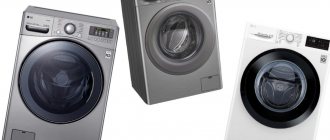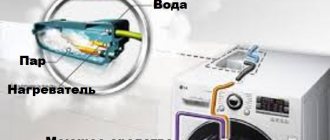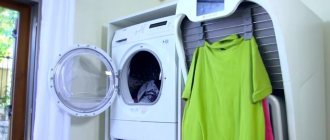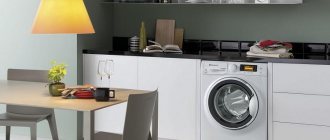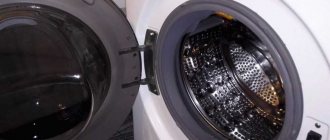An automatic washing machine is one of the most important and irreplaceable elements of the interior of any apartment or house. It simplifies household management as much as possible, saving energy and time for the owners. True, not all of them also save space in those rooms where it is already limited. The solution to this problem is to purchase a washing machine under the sink. How is it different from the regular full-size version? Does reducing the size of a device reduce its functionality? How not to make a mistake in choosing a device? These and many other questions will be answered in this article.
History of appearance
From time immemorial, humanity has been concerned about the cleanliness of its wardrobe items. Naturally, before the invention of the washing machine, you had to wash by hand. Cleaning clothes took a colossal amount of effort and time—a whole day was set aside specifically for this activity.
People used all kinds of improvised means to facilitate the process. Perhaps the easiest thing was for the sailors, who, although they had to wash themselves, were helped by a pond - the soaped clothes were tied to a rope, then lowered over the side of the ship and rinsed with the flow of water. On land, everything was much more difficult - the fabric got dirty faster, and more effort had to be put in, because the only help was the ribbed boards.
A big leap in the development of washing technology occurred during the gold rushes. Craftsmen not only made life easier by inventing various units, but also made good money from it.
The first device, located in the first laundry, began operating in 1851 in California. The unit was quite cumbersome, could clean up to 15 shirts at a time, and was driven by 10 harnessed mullahs. Also in 1851, James King invented another type of washing device. It consisted of two cylinders: one, a large one, included a second, a small one with dozens of holes. This structure made it possible to create simultaneous movement of liquid and clothing. The invention made a splash in its time, even though it was entirely manual.
Over the next 14 years, more than two thousand patents were issued for the invention of the washing machine. And already in 1875, William Blackstone launched their first mass production.
In Europe, recognition for the first such invention belongs to Carl Millet, who received a patent for his machine in 1900.
The first fully automated machine appeared in 1908, thanks to the American Alva Fisher, who equipped the device with an electric motor. Although the invention was not ideal from a safety point of view, it immediately gained enormous popularity among those who wanted to finally rid themselves of the need for manual labor in the washing process.
The next turning point in the history of the development of the washing machine can be considered 1949, in which the first automatic machine appeared. Since then, devices have been equipped with more and more functions. In the 1950s, the spin function appeared, in the 1990s - a full washing cycle according to parameters entered by the user.
Now the product market is teeming with cars of all sizes, designs and functionality. Everyone will be able to find an option that suits all their desired parameters.
Installation Rules
When installing a sink above a washing machine in the bathroom (photo below), you need to remember a few basic principles.
- When planning co-location, consider the location of communications so that there is no direct contact between water and electricity.
- Please note that you will need a special siphon for the washbasin: with an outlet for the washing machine, a splitter or with a check valve. The latter blocks wastewater and prevents it from reaching the drain if the pipe becomes clogged. It is also advisable to install a special overflow drain that will prevent water from overflowing the edge of the bowl.
- Installation occurs in the following order: a plan with markings for the brackets, their installation (attached to dowels or anchors), installation of all sink elements, connection of the washing machine and communications. Afterwards, be sure to check whether the equipment works.
- If the bowl is shallow, provide the washing machine with protection from splashes - the best solution for this is a countertop.
- Since equipment vibrates during washing, ensure there is space between the walls of the appliance, siphons and fastenings so that they do not get damaged or become loose. For the same reason, it is better not to place the unit close to the wall - constant vibration will not benefit the finish. And to reduce movement when washing, you can put a rubber mat down.
- After the machine is installed, check that all connections are tight. It is better to additionally secure them with clamps. This is necessary to avoid water leakage, which will be difficult to clean behind equipment installed under the surface.
Instagram @irgil
Instagram @ekaterina_kodinceva
Instagram @projection_design
Instagram @krylova_design
Device
The basic parts and operating principles are the same for almost all models and brands of washing machines. The only exceptions are units with vertical loading and units with a drying function.
Here is a list of the main components of the device:
- Housing consisting of panels, top cover and hatch door;
- Control Panel;
- Electronic module;
- Tank and drum;
- Engine;
- Tubular electric heater;
- Water intake system, including valves, water level sensors and some other components;
- Water drainage system: drain sediment, filter and other components;
- Balancing system: springs and shock absorbers.
Some models may contain additional nodes. In some devices they are expressed in simple sensors, in others - in entire systems (for example, a leakage protection system).
Features of choice
Washing machines designed for installation under the sink have their own characteristics. This is a technique with compact dimensions - after all, the user should be comfortable using not only the washing machine, but also the sink located on top.
In order to place compact appliances under the sink, a number of criteria must be taken into account.
Let's talk about them in more detail later.
- Type of installation and loading. According to the type of installation, washing machines for installation under the sink can be fully built-in or free-standing. Stand-alone varieties are represented by a wider range of products, since the production of such equipment is established by many manufacturers. The choice of loading type is limited to front-facing models.
- Dimensions and capacity. When choosing a washing machine for installation under the washbasin, it is important to take into account the following dimensions of the device - height should not exceed 70 centimeters, depth - no more than 51 centimeters, width - up to 51 centimeters. Only in this case the sink will not be located too high and will be able to completely close the lid of the washing unit, preventing splashes. The capacity of such devices usually does not exceed 4 kilograms of dry things.
- Number of programs and availability of additional functions. Most well-known manufacturers equip devices with a standard set of programs, including the ability to accelerate cycles and care for woolen and delicate items. An important parameter is the presence of complete or at least partial protection against leaks and blocking of the control unit.
- Many equipment owners value the reduced noise level produced by the device during operation. In this matter, it is recommended to focus not only on the information provided by the manufacturer in the instructions, but also to study the reviews of people who have already managed to evaluate the selected model in practice.
- Technical specifications. Control type - mechanical or electronic, information display. the number of possible washing modes and the spin class of the laundry, the energy efficiency of the model are selected taking into account your own preferences. It is important to remember that a greater number of additional options always significantly increases the cost of a technical device.
Principle of operation
The washing process begins by collecting liquid from the water supply; it enters through the inlet valve, which opens after a signal from the electronic module. Until a sufficient water level is reached (this indicator is monitored by a pressure switch), it will flow into the detergent compartment and into the tank.
After a signal is given to close the valve for incoming water, the heating element starts working: it heats the liquid to the temperature selected by the user.
The process of cleaning laundry is as follows: water with dissolved detergents enters the drum with clothing items through the holes. The fabric is mixed, comes into contact with the corrugated surface of the drum, which rotates in different directions and at different speeds, and thus is cleaned evenly and efficiently.
The final stage of washing is spinning, during which the drum rotates at maximum speed, due to which excess moisture is removed from the clothes.
Dirty water is pumped into the sewer using a pump.
Varieties
At the moment, the product market presents to the buyer a wide variety of models of washing machines. Let's look at the most interesting of them.
Manual
This type is a small mechanical device that does not need to be connected to a water supply or connected to an electrical network. An ideal option for those who enjoy frequent trips to nature.
Strengths:
- Extremely miniature, will not take up much space even in the most compact trunk;
- The only condition necessary to use the device is the presence of some supply of water or a reservoir nearby;
- Easy to operate;
- Suitable for delicate washing.
Weak sides:
- When purchasing this device, you must be prepared in advance for the fact that you will have to turn the handle or press the pedal for the entire washing cycle;
- Lack of spin and dry modes;
- The need to independently heat water.
Semi-automatic
Such models are the most suitable option for residents of rural areas, because they only require an electrical connection.
The device pleases:
- Affordability;
- Ease of operation;
- Rare occurrence of breakdowns and malfunctions.
However, the unit:
- Requires independent filling and draining of water not only at the beginning and at the end of the washing cycle, but also for rinsing;
- Requires independent heating of the liquid.
Automatic
Washing machines familiar to everyone, operating according to user-entered parameters, requiring connection to water supply, electricity, and sewerage.
Pros:
- Minimum expenditure of effort by the user, all his actions are limited to loading laundry, adding or pouring detergent, selecting a washing program and starting it;
- High quality washing;
- Large capacity and, accordingly, saving time on cleaning clothes.
Minuses:
- Automatic washing machines are quite bulky and require a lot of space, which you should think about allocating before purchasing;
- Possibility of installation difficulties.
Top loading
This is an automatic model, the hatch for loading laundry is located at the top.
Advantages:
- No need to bend over to load clothes;
- Large drum capacity;
- Brings less discomfort due to minimal noise emitted.
Flaws:
- This model cannot be built into a countertop.
Candy Aqua 104D2-07 – fast and inexpensive washing machine
The compact machine, 70 cm high and 43 cm deep, can hold up to 4 kg of laundry, so it can handle most everyday tasks.
The model has a spin function with an adjustable rotation speed of up to 1000 rpm, but most importantly, it ensures ideal washing of clothes (washing quality corresponds to class A).
Pros:
- The stainless steel drum is reliable and durable.
- High energy efficiency class A.
- 17 automatic programs for different types of fabrics.
- There is a quick wash (14, 30 and 59 minutes), as well as an “anti-allergenic” rinse, which is rare for machines of this class.
- The built-in sensor determines the weight of the loaded laundry, after which the necessary adjustments are made to the program.
- Possibility to delay the start for any period up to a day.
- The cost of 18-21 thousand rubles is the lowest in this segment.
Minuses:
- It’s a bit noisy – when washing it produces a sound of 56 dB, but you can’t hear it behind a locked bathroom door.
- The maximum water temperature does not exceed +75 °C.
Recommendations: 19 best washing powders
Washing machines under the sink
We talked about this type of washing machine at the very beginning of the article. Let us remember that their main purpose is to save space in small rooms and, as a result, to gain the opportunity to use the freed up space more rationally.
What advantages and disadvantages do such models have?
Advantages and disadvantages
Users of such units note the following strengths:
- The ability to use the freed up space for your own purposes;
- Saving material resources by reducing water and electricity costs;
- The device is extremely convenient to use, for example, due to its relatively low weight, it can be moved independently if necessary;
- Affordable price.
Users note the following points as weaknesses:
- The maximum load withstand is only 3.5 kg;
- The range of available programs is meager compared to full-size analogues;
- Mounting such a device is only possible under a sink with a special siphon, which must be changed periodically due to its tendency to become clogged;
- The range of sinks and accessories for them is quite limited.
Parameters worth paying attention to
Here are some tips to help you avoid making the wrong choice:
- The most convenient height of the device is 70-75 cm. Thanks to this value of this value, a device with a washbasin on top of it will be convenient to use for both children and adults.
- When selecting, it is also worth taking into account such a value as depth. A machine sticking out from under the washbasin spoils the appearance of the room in which it is located. The best option is a device with a depth of 50 cm.
- Speaking of width, in most cases it does not differ from the width of the standard model. In general, it should be selected based on the size of the room and the intended location of the device.
Rating of the TOP 5 best models
| Place | Name | Price |
| TOP 5 washing machines under the sink | ||
| 1 | Eurosoba 1100 Sprint | 55 000 ₽ |
| 2 | Eurosoba 600 | 35 000 ₽ |
| 3 | Leran WMXS 15104 WD | 15 000 ₽ |
| 4 | Eurosoba 1000 | 44 000 ₽ |
| 5 | Eurosoba 1100 Sprint Plus Inox | 70 000 ₽ |
Types of shell
There are special types of washbasins designed specifically for use above washing machines, because a standard sink with a deep bottom is not suitable for this purpose.
Water lily
One of the most common options is the water lily shell. They love it for its side height, which reaches about 20 cm. This type is divided into two subtypes:
- Light. It is distinguished by the absence of a hole for the mixer, elegance and compactness. A great option for small bathrooms.
- Uni. It differs from the previous subtype in its larger dimensions and deeper sides.
Built-in or surface mounted
The cost of built-in and overhead models is higher than the cost of water lilies, however, this is fully justified by their stylish and original appearance and ability to fit into any interior of a house or apartment.
Form
The product market provides the buyer with the opportunity to create an even more interesting bathroom design using sinks of different shapes: round, oval, rectangular, with rounded corners.
What to look for when choosing?
The main selection criterion is dimensions. The height of mini electrical equipment does not exceed 67-70 cm. The depth varies in the range from 44 to 51 cm, but the width can reach 55 cm. The secret of the right choice lies in the nuances:
- After installation, equipment should not protrude beyond the sink, especially in front;
- when connecting the drain and hose for water intake, kinks and pinches must not be allowed (from the wall to the back panel of the electrical appliance there must be at least 10 cm);
- installation of the sink should not interfere with the installation of the sink siphon; bends and turns should not be allowed.
A washing machine installed under the sink provides comfort and space saving. The equipment is designed to ensure correct installation and connection of pipes. Therefore, size is the main selection criterion.
If after installation it is uncomfortable to use a sink or electrical appliance, it means that the choice was made incorrectly. This will affect the service life of the unit and the comfort of using the sink.
Having calculated the dimensions, we begin to search for a model using other criteria:
- basic options;
- auto programs;
- additional functions;
- loading hatch size;
- intuitive control panel;
- power;
- design, manufacturer.
Don't forget that a bathroom can be both spacious and beautiful. Manufacturers of household appliances and plumbing fixtures release models of various colors, geometries, and styles to the market.
TOP best washing machines under the sink for 2022
TOP best budget options
CANDY 1D1035
Compact (length/width/height: 51 cm/46.4 cm/70 cm), but quite spacious model: it is possible to clean 3.5 kg of laundry in one cycle. CANDY 1D1035 is equipped with 16 different washing programs suitable for different types of fabric. The highlight of this model is the automatic weighing of loaded items and the presence of a foam suppression system.
Price: 24,000 rub.
CANDY 1D1035
Advantages:
- High spin speed;
- Presence of door lock function;
- Availability of an imbalance control system;
- Economical.
Flaws:
- No drying mode;
- The length of the network cable is short.
CANDY AQUA 104D2-07
Customers who purchased this model have never regretted their choice. And that's all, because the weight of CANDY AQUA 104D2-07 is not at all large - 48 kg, and the drum capacity is greater than that of its analogues - 4 kg. The device is extremely economical - it consumes only 0.79 kW per hour and 27 liters of water. Users also note the low amount of noise produced. Just like the previous version, it is equipped with 16 programs.
A useful addition is the function of delaying the wash cycle for 24 hours.
Cost: 27,000 rub.
CANDY AQUA 104D2-07
Pros:
- Stylish modern design;
- User-friendly interface;
- High power with low power consumption.
Minuses:
- Poor quality of washing in low water temperature mode.
LG F-1096ND3
A relatively small device with simple electronic controls and a user-friendly interface. Equipped with 13 washing modes. It uses electricity and water economically, for which it is appreciated by its users.
Buyers also note useful additional functions, including: a door locking system, a leakage protection system, a foam suppression system, as well as a minimal level of noise emitted during operation.
Price: 19,500 rub.
LG F-1096ND3
Advantages:
- Stylish design;
- Ease of operation;
- The presence of a sound signal notifying the end of the washing process.
Flaws:
- Some modes are designed for long-term (more than three hours) washing.
Candy Aquamatic 135 2D
Small washing machine with big capabilities
An inexpensive model from the famous Italian brand, specially designed for installation in a small bathroom. Its depth is only 46 cm, and the maximum load is no more than 4 kg. The machine is designed for washing clothes from a wide variety of fabrics, for which 16 programs are provided.
+ Pros of Candy Aquamatic 135 2D
- the presence of a special program for improved rinsing, which will be appreciated by allergy sufferers and those with small children;
- high-quality spin, presented in various variations with a maximum mode of 1100 revolutions and the ability to cancel the process;
- special programs for fine fabrics and wool products;
- electronic intelligent control with display on a digital display;
- low power consumption;
- foam control;
- possibility of delaying start up to 24 hours;
- reasonable cost, averaging 20,500 rubles.
— Cons of Candy Aquamatic 135 2D
- lack of a control panel locking function to prevent accidental pressing of buttons;
- partial protection against water leakage;
- The tank is made of plastic, which is inferior in strength to metal options.
